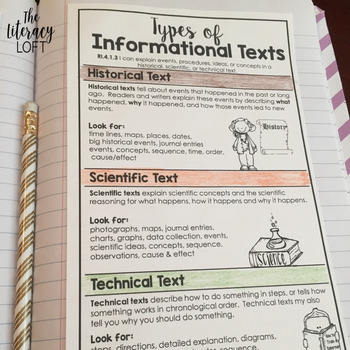Reading Notebook Anchor Charts (BUNDLE)
- Zip
What educators are saying
Products in this Bundle (2)
Also included in
- This unit has been updated 8.14.2017 to include Book Reviews. What is included?This bundle includes my favorite and most used Reading and Writing Unit resources in a package that saves you 20%. This reading and writing bundle includes the resources listed below. You can click on any of the links tPrice $67.80Original Price $81.00Save $13.20
Description
This product includes anchor charts for each Reading Literature and Informational Standard for Grades 3-5 that provide skills and strategies at your students' fingertips.
Why Reading Notebook Anchor Charts?
The charts in this product are meant to be used inside students’ reading or writing notebooks. This is why they are shown two on a page. I don’t know about you, but the budget on copies has always been an issue we are always trying to find ways to save paper and copies!
More importantly, as ELA teachers we tend to use a lot of anchor charts in our classroom. With the number of charts we make- it would be impossible to keep all of them up throughout the year and sometimes students probably forget they are even there. Having them right in their notebooks allows easy accessibility to help during independent Reading or Writing. You might also find these useful for parents to use at home.
Since I began using anchor charts inside our Reading and Writing Notebooks, I have noticed my students are able to work better independently. They have the tools they need to support their learning. The charts have also been helpful in planning and presenting lessons. For example, when talking about “theme,” you have examples and ways to find it by using the chart. This helps to bring a large and broad topic down to a concrete idea.
This set also includes a variety of graphic organizers for both fiction and nonfiction.
What is included?
>>> READING LITERATURE CHARTS <<<
The following charts are included aligned to the 3 clusters of the Reading Literature Standards for Grades 3-5.
Key Ideas & Details
- Wise Readers ask Questions Who… What…When…Where…Why…How
- Using Text Evidence
- Inference
- Character Feelings
- Character Traits
- Recount Stories (Somebody Wanted But So Then)
- Recount Stories (Who? What? When? Where? Why? How?)
- Summarize Stories (Somebody Wanted But So)
- Think FAST about the Characters
- FAST Chart (3 Versions)
- 5 Elements of a Story
- Story Mountain
- Crafting a Theme Statement
- Theme
- THEMEssage
- Common Themes
Craft & Structure
- Literal vs. Nonliteral Language
- Figurative Language
- Idioms 1 (blank)
- Idioms 2 (blank)
- Idioms 1
- Idioms 2
- Allusion
- Poetry, Drama, & Prose
- Point of View
- Point of View (blank)
Integration of Knowledge & Ideas
- The Quest
- Movie vs. Text (Blank)
- Movie vs. Text (Filled in)
- Comparing Themes, Topics, & Patterns of Events
- Good vs. Evil
- Thinking about Theme
- Revealing the Theme
Extra Reading Charts & Tools
- The Story in a Nutshell Graphic Organizer (1 per page)
- The Story in a Nutshell Graphic Organizer (2 per page)
- Main Idea & Details Boxes & Bullets (2 per page)
- What's the Big Idea?! Boxes & Bullets Graphic Organizer for Text
- Writing a Summary (1 per page)
- Let's Talk Genre! (Genre Notebook Chart)
- Traditional Literature Notebook Chart
- My Reading Log (2 per page)
- Words We Should All Spell Correctly
- Transitions
- Responding to Fiction 1
- Responding to Fiction 2
- Responding to Nonfiction
- Readers Choose Just Right Books
- My New Year's Reading Resolutions
- Ways I Can Help Myself Grow as a Reader
- Parts of Speech
- Reading is Thinking (boy)
- Reading is Thinking (girl)
>>> READING INFORMATIONAL NOTEBOOK CHARTS <<<
Key Ideas & Details
- Super Star Partnerships
- Wise Readers Ask Questions
- Using Text Evidence
- Types of Informational Texts
- Main Ideas and Supporting Details
- Inference
- Talking about the Text
- Main Idea and Key Details (Graphic Organizer)
- Main Idea and Key Details (Graphic Organizer)
- Summarizing Nonfiction (Somebody Wanted But So)
- Summarizing Nonfiction (Notes with Example)
- Summarizing Nonfiction (Notes with Example) cursive font
- Determining Importance
- Determining Importance (Interesting or Important)
- Sentence Starters for Main Idea
- See, Think, Wonder (Blank)
Craft & Structure
- Alpha Boxes
- Context Clues
- Firsthand vs. Secondhand Account
- Primary vs. Secondary Sources
- Description
- Sequence
- Compare & Contrast
- Cause & Effect
- Problem & Solution
- Cause & Effect Graphic Organizer
- Nonfiction Signal Words 1
- Nonfiction Signal Words 2
Integration of Knowledge & Ideas
- Reasons & Evidence
- Text Features 1
- Text Features 2
- Text Features 3
- Combining Texts
- Combining Texts
- Combining Texts (Graphic Organizer)
- Bonus* Readers Gonna Read (My To-Read List)
If you ever find that you are looking for a specific chart that is not included, please let me know at help@theliteracyloft.com. I am ALWAYS looking for ways to improve the quality of my resources. :)
You and your students might also LOVE...
I'm the Expert! {An Informational Writing Unit}
My Life is A Story {A Personal Narrative Writing Unit}
Division Task Cards {Division is SNOW much fun!}
Math Morning Work for the Year! (4th Grade)
Buzzin' in Book Clubs {Book Club Reading Unit Resources}
Newspaper Article Writing Unit {Here's the Scoop!}
Opinion Writing for a Literary Response
Current Events Writing {What's the Scoop?}
Let’s connect!
The Literacy Loft on Instagram






